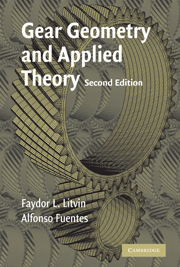Book contents
- Frontmatter
- Contents
- Foreword by Graziano Curti
- Preface
- Acknowledgments
- 1 Coordinate Transformation
- 2 Relative Velocity
- 3 Centrodes, Axodes, and Operating Pitch Surfaces
- 4 Planar Curves
- 5 Surfaces
- 6 Conjugated Surfaces and Curves
- 7 Curvatures of Surfaces and Curves
- 8 Mating Surfaces: Curvature Relations, Contact Ellipse
- 9 Computerized Simulation of Meshing and Contact
- 10 Spur Involute Gears
- 11 Internal Involute Gears
- 12 Noncircular Gears
- 13 Cycloidal Gearing
- 14 Involute Helical Gears with Parallel Axes
- 15 Modified Involute Gears
- 16 Involute Helical Gears with Crossed Axes
- 17 New Version of Novikov–Wildhaber Helical Gears
- 18 Face-Gear Drives
- 19 Worm-Gear Drives with Cylindrical Worms
- 20 Double-Enveloping Worm-Gear Drives
- 21 Spiral Bevel Gears
- 22 Hypoid Gear Drives
- 23 Planetary Gear Trains
- 24 Generation of Helicoids
- 25 Design of Flyblades
- 26 Generation of Surfaces by CNC Machines
- 27 Overwire (Ball) Measurement
- 28 Minimization of Deviations of Gear Real Tooth Surfaces
- References
- Index
18 - Face-Gear Drives
Published online by Cambridge University Press: 04 September 2009
- Frontmatter
- Contents
- Foreword by Graziano Curti
- Preface
- Acknowledgments
- 1 Coordinate Transformation
- 2 Relative Velocity
- 3 Centrodes, Axodes, and Operating Pitch Surfaces
- 4 Planar Curves
- 5 Surfaces
- 6 Conjugated Surfaces and Curves
- 7 Curvatures of Surfaces and Curves
- 8 Mating Surfaces: Curvature Relations, Contact Ellipse
- 9 Computerized Simulation of Meshing and Contact
- 10 Spur Involute Gears
- 11 Internal Involute Gears
- 12 Noncircular Gears
- 13 Cycloidal Gearing
- 14 Involute Helical Gears with Parallel Axes
- 15 Modified Involute Gears
- 16 Involute Helical Gears with Crossed Axes
- 17 New Version of Novikov–Wildhaber Helical Gears
- 18 Face-Gear Drives
- 19 Worm-Gear Drives with Cylindrical Worms
- 20 Double-Enveloping Worm-Gear Drives
- 21 Spiral Bevel Gears
- 22 Hypoid Gear Drives
- 23 Planetary Gear Trains
- 24 Generation of Helicoids
- 25 Design of Flyblades
- 26 Generation of Surfaces by CNC Machines
- 27 Overwire (Ball) Measurement
- 28 Minimization of Deviations of Gear Real Tooth Surfaces
- References
- Index
Summary
INTRODUCTION
A conventional face-gear drive is formed by an involute spur pinion and a conjugated face-gear (Fig. 18.1.1). Such a gear drive may be applied for transformation of rotation between intersected and crossed axes. An important example of application of a face-gear drive with intersected axes is in the helicopter transmission (Fig. 18.1.2).
The manufacturing of face-gears by a shaper was invented by the Fellow Corporation. The basic idea of generation is based on simulation of meshing of the generating shaper with the face-gear being generated as the meshing of the pinion of the drive with the face-gear. In the process of generation, the surfaces of the teeth of the shaper and the face-gear are in line contact at every instant. However, when the shaper is exactly identical to the pinion of the face-gear drive, the generated face-gear drive becomes sensitive to misalignment. This causes an undesirable shift of the bearing contact and even separation of the surfaces. Therefore, it is necessary to provide an instantaneous point contact between the tooth surfaces of the pinion and the face-gear instead of a line contact. Then, the bearing contact will be localized and the face-gear drive will be less sensitive to misalignment. Point contact between the pinion and face-gear tooth surfaces is provided by application of a shaper of number of teeth Ns > Np where Np is the number of teeth of the pinion of the drive (see Section 18.4).
- Type
- Chapter
- Information
- Gear Geometry and Applied Theory , pp. 508 - 546Publisher: Cambridge University PressPrint publication year: 2004
- 3
- Cited by

